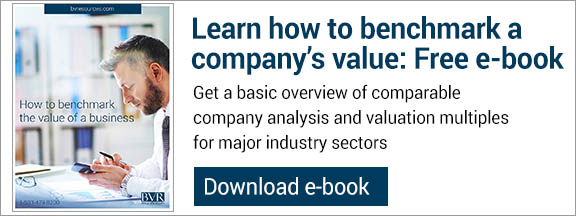What’s a business worth? How to benchmark the value of a private company
What’s a business worth? It’s a question that arises frequently for business owners, business intermediaries, and a wide spectrum of tax and financial professionals. Of course, every business is unique, and therefore there is no formulaic one-size-fits-all model for how to value a business, and an appraiser utilizes his or her professional judgment, experience, and analysis to reach a valuation conclusion.
But what if you want a general ballpark value of what a specific business is worth?
One way to determine this is to look at how much others have paid for similar businesses relative to different earnings measures. This post will give you a basic overview of comparable company analysis and provide you with valuation multiples for major industry sectors in BVR’s How to Benchmark the Value of a Business e-book.
First let's consider three financial metrics:
- Revenues: The total amount of money that is brought into a company by its business activities. Sometimes referred to as the “top line” and is prior to any expense deduction, including materials.
- EBITDA: An acronym for earnings before interest, taxes, depreciation, and amortization. These are the earnings of the business before the aforementioned expenses.
- Seller’s discretionary earnings (SDE): One measure of earnings to an owner/operator of a business. This figure is calculated by adding owner’s salary to EBITDA.
When benchmarking the value of a business, we compare the above earnings measures to selling prices of a similar business to create a ratio, also known as a business selling price multiple or valuation multiple. Selling price to revenue (or selling price/revenue) is the selling price of the sold business divided by that business’s revenue. If a benchmark company sold for $1 million and it had yearly revenues of $2 million, we would say it sold for 0.50 times revenue ($1 million/$2 million). Said another way, the selling price/revenue business valuation multiple is 0.50.
You can use this metric as an estimate or benchmark for a specific business’s worth. For example, if a business had $3 million in revenue and a 0.50 selling price/revenue business valuation multiple was selected from a benchmark company, you could estimate that business’s worth to be $1.5 million ($3 million × 0.50). But to determine a private company’s enterprise value, we don’t typically look at one comparable business sale in isolation. Rather, we consider a median valuation multiple for a group of businesses in an industry or part of an industry.
Want more? View selling price multiples and valuation benchmarks
To access valuation multiples based on thousands of sold businesses in major industry sectors and to get additional tips for using comparable M&A transactions as a valuation benchmark, download BVR’s How to Benchmark the Value of a Business. This e-book offers proprietary statistics on enterprise value selling prices based on thousands of real private-company deals listed in BVR’s Pratt’s Stats database. These hard-to-find private transaction details are sourced from a global network of contributing business intermediaries.
Want to go beyond benchmarks? BVR offers all the tools you need to perform an advanced valuation analysis, including comparable transaction data and calculators, methodology guidance, training webinars, and an expansive range of free resources.

